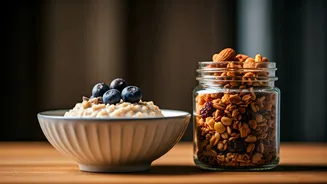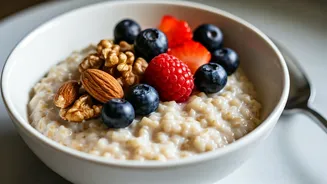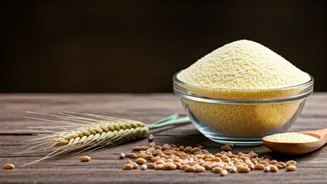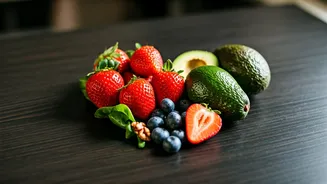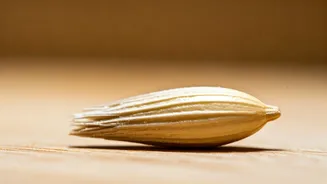Oats: Nutritional Powerhouse
Oats, often hailed as a breakfast champion, are a nutritional powerhouse, brimming with soluble fiber, particularly beta-glucan. This fiber is instrumental
in lowering cholesterol levels and promoting heart health. Furthermore, oats offer a slow-release energy source, preventing blood sugar spikes and crashes, which aids in managing hunger and controlling cravings. Oats are also relatively low in calories and can be prepared in various ways, such as oatmeal, overnight oats, or used in savory dishes. This versatility makes them a simple yet effective tool for weight management. Their high fiber content leads to increased satiety, making you feel full for longer, thus curbing overeating and supporting weight loss efforts. Oats can be easily customized with fruits, nuts, and seeds to enhance their nutritional value and taste, making them a balanced and satisfying meal.
Granola: Factors to Consider
Granola, while seemingly healthy, often comes with hidden calories and sugars. Commercially produced granola can contain significant amounts of added sugars, fats, and sometimes even artificial ingredients, which can hinder weight loss efforts. However, the nutritional profile of granola can vary greatly depending on its ingredients. Homemade granola can be a healthier alternative, allowing you to control the sugar and fat content. When choosing granola, it's crucial to read labels carefully and opt for options with low sugar, high fiber, and healthy fats. Look for granola made with whole grains, nuts, and seeds, and avoid those with excessive amounts of added sweeteners. Granola can provide essential nutrients, such as fiber, protein, and healthy fats, but the caloric density and added sugar content can make it less suitable for weight loss than oats, unless carefully monitored and consumed in moderation.
Comparing the Two
Comparing oats and granola, the primary distinction lies in their processing and ingredient profiles. Oats, in their natural state, are minimally processed, retaining their beneficial nutrients and fiber. Granola, on the other hand, undergoes more processing and often includes added ingredients like sweeteners and oils. In terms of weight loss, oats generally have an edge due to their lower calorie density and higher fiber content, which promotes satiety. The high fiber content of oats helps regulate blood sugar levels, preventing hunger pangs and supporting weight management. Granola, while providing some nutritional benefits, often contains more calories and added sugars, potentially working against weight loss goals. However, the overall impact depends significantly on the choices made when selecting or preparing each option. If opting for granola, the homemade variety allows control over ingredients, making it a potentially healthier choice than store-bought options that often contain excessive amounts of sugar.
Making Informed Choices
Making informed choices when it comes to oats and granola involves understanding their nutritional compositions and how they align with your weight loss goals. For weight loss, opting for plain oats with added fruits, nuts, and seeds is often the better choice. This approach allows you to control sugar and calorie intake while maximizing fiber and nutrient consumption. If you enjoy granola, consider making it at home using healthy ingredients like rolled oats, nuts, seeds, and natural sweeteners such as honey or maple syrup in moderation. Reading nutrition labels carefully is also crucial. Compare the serving sizes, calorie counts, sugar levels, and fiber content of different granola brands. Choose options with minimal added sugar and higher fiber content. Portion control is also key. Even a healthy food like granola can lead to weight gain if consumed in excess. Being mindful of portion sizes helps balance your diet while enjoying your favorite foods.
Smart Dietary Strategies
Implementing smart dietary strategies is essential for maximizing the benefits of oats and granola in your weight loss journey. For oats, experiment with various toppings to enhance both taste and nutrition. Add berries for antioxidants, nuts and seeds for healthy fats and protein, and a touch of cinnamon for added flavor and blood sugar control. When choosing granola, read labels meticulously and aim for options with lower sugar content. Use granola sparingly as a topping for yogurt or oatmeal to add texture and flavor without overdoing calories. Consider making your own granola at home, adjusting the ingredients to fit your preferences and health goals. Incorporate oats and granola into your diet gradually to monitor your body's response and adjust portion sizes as needed. Combine these breakfast options with a balanced diet, including lean proteins, vegetables, and other whole foods, for optimal results. Furthermore, stay consistent with your dietary choices, as long-term success requires sustained effort and mindful eating habits.
